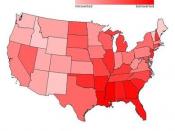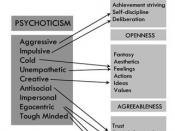The Five Factor Model has taken various forms over the years but has more recently taken the form of the OCEAN model of McCrae and Costa and the Big Five model of Goldberg. Both of these models although derived from different methodologies are an attempt to explain human behaviour using traits. There has been much debate as to whether these conceptual models do in fact explain behaviour or whether they are just descriptive of behaviour.
Carr and Kingsbury (1938) defined "trait" as "a conceptual attribute or definition of the reactive nature of an individual" where "the nature of an individual is defined on the basis of certain observable behaviour characteristics....which society regards as of sufficient importance to identify and name and.....which are regarded as expressions or manifestations of the constitutional nature of the individual". They regarded "traits" as "conceptual realities" akin to "engrams, nerve traces and neural modifications" which cannot be observed other than through their behaviour manifestations.
Johnson further defined "traits" as "consistent patterns of thoughts, feelings, or actions that distinguish people from one another". He justified the study of traits in personality on the basis that science requires the studying of consistencies. McCrae and Costa (1990) similarly define "traits" as "dimensions of individual differences in tendencies to show consistent patterns of thoughts, feelings, and actions" but also used it in the broader context to refer to "a property of an individual that accounts for his or her placement along this trait dimension". Other psychologists feel that "traits" are "patterns of behaviour" (eg Buss and Craik, 1983; Mischel and Shoda, 1994). On a more sophisticated level Alston (1975) regarded "traits" as "dispositions to respond to certain stimuli with certain responses".
A further distinction has been made between two levels of traits; one relating to patterns of behaviour and experience...


